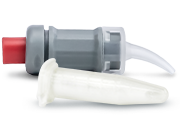
The University of Nevada, Las Vegas, (UNLV) School of Dental Medicine Advanced Education in Pediatric Dentistry is an innovative residency program that prides itself on keeping up with the cutting edge of products and services offered in the world of pediatric dentistry.
The field of pediatric dentistry is constantly changing, ranging from preventative measures through full comprehensive treatment. We are no longer considered the “baby-tooth doctor.” Our treatment plan starts with developing a rapport first with the patient, then with the parent. Many parents who conduct their own research prefer treatment to be delivered without drugs. Dentistry has now become more relationship based than ever.
Our children can now have happy smiles restored even if their teeth have been severely damaged.
Our children can now have happy smiles restored even if their teeth have been severely damaged. This is true regardless of how the damage occurred—whether through extended bottle usage (milk-bottle caries), through extended finger habits, or as a result of trauma. Pediatric dentistry interfaces with endodontics (facilitating apical closure using MTA), early orthodontic treatment (developing the maxillary and mandibular arches to accommodate their permanent successors), and restorative dentistry that emphasizes esthetics. We now have the products, techniques, and skills to restore dental structures to a near-natural-like state.

The diverse staff associated with our residency program ranges from pediatric dentists with 30-plus years of experience to the new pediatric dentist graduate. Our program embraces change and prides itself with ensuring that our residents learn to embrace cutting-edge technology. This commitment on our part allows a resident to maintain a balance, sampling a relationship with the old guard while keeping up with the newest advances in sedation.
The importance of how parents perceive a child’s appearance has skyrocketed recently, forcing the pediatric dental community to provide a service that is in line with parental expectations. Today’s parents place an increasing priority on how their children are perceived by their peers. Pediatric dentistry also has been impacted by other changes in society and the economy, such as parents buying $300 shoes for their 3-year-olds. Given this shift in outlook, unsightly stainless steel anterior crowns, bulky white-faced stainless steel crowns, and silver fillings are no longer an acceptable choice for many parents. They want esthetics, no matter what the cost.
In this new environment, Sprig introduced an esthetic Zirconia crown that met a pent-up demand for a more esthetic restoration. Fortunately, we can now offer parents the option of using crowns that are naturally life-like in appearance. Children are no longer stigmatized by unsightly crowns, and parents now have the option to give their child the smile they feel they deserve.
The importance of how parents perceive a child’s appearance has skyrocketed.
Sprig EZcrowns have been the crown of choice for me from their beginning. Dr. Hansen graciously came to UNLV School of Dental Medicine Advanced Education Program in Pediatric Dentistry and gave our residents a lecture and hands-on presentation in 2013. In 2015, I, along with another faculty member and two residents, attended Sprig University in Los Angeles, a first-class event demonstrating how to prepare and market Sprigs EZcrowns. I would highly recommend that all future pedodontic residents take this course to hone their skills in order to offer this service upon completing their residency training.
Our residency program uses a variety of esthetic crowns, but in my opinion, Sprig’s attention to quality control is more consistent than the other manufacturers of Zirconia crowns. Now more than ever, our residents’ choice of restoration for restoring decayed teeth is the Sprig EZcrown. The natural, life-like look of these crowns provides a more viable alternative for restoring both anterior and posterior teeth.
Sprig’s revolutionary innovation affords our residents a huge advantage of being able to train using this groundbreaking restoration that will be highly sought after once they leave the UNLV residency program.





